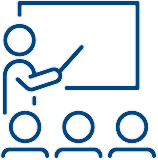What Is Orton-Gillingham?
The Orton-Gillingham methodology combines direct, multi-sensory teaching strategies with systematic, sequential lessons focused
on phonics.
About Orton and Gillingham
Orton-Gillingham was among the first teaching approaches designed to help struggling readers by explicitly teaching the connections between letters and sounds. In the 1930s, neuropsychiatrist and pathologist Dr. Samuel T. Orton and educator, psychologist Anna Gillingham developed the Orton-Gillingham approach to reading instruction for students with “word-blindness,” which would later become known as dyslexia. Their approach combined direct, multi-sensory teaching strategies paired with systematic, sequential lessons focused on phonics.

The Orton-Gillingham Approach
Orton-Gillingham is a highly structured approach that breaks reading and spelling down into smaller skills involving letters and sounds and then builds on these skills over time. It was the first approach to use explicit, direct, sequential, systematic, multi-sensory instruction to teach reading, which is effective for all students and essential for teaching students with dyslexia.

Orton-Gillingham and Dyslexia
Throughout the 1930s and 1940s, the fundamental philosophies of Orton-Gillingham were developed by Dr. Samuel Orton and educator Anna Gillingham. They believed that students with strephosymbolia (twisted symbols), what we now call Dyslexia, needed a multisensory approach to their literacy education that included the use of auditory, visual, and kinesthetic channels. A multi-sensory approach means students are learning language by ear (listening), mouth (speaking), eyes (seeing), and hand (writing). The process involves listening to sounds and saying the sounds and names of letters while writing them.
View all of the latest articles and research about Orton-Gillingham and Structured Literacy
Expand your knowledge on Orton-Gillingham history and the Orton-Gillingham approach

Learn more about live-virtual,
in-person, and asynchronous training options
See Orton-Gillingham as a Part of Structured Literacy Training in Action
Structured Literacy can ensure that students are equally exposed to important foundational literacy skills in a sequential, systematic, and cumulative way.
